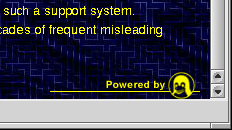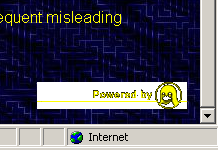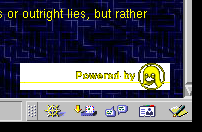

Modern tools.
Traditional dedication.
![]() Home
| Purpose
| Linux
| Products
| Legality
| Special
| Downloads
| Articles
| Contact
Home
| Purpose
| Linux
| Products
| Legality
| Special
| Downloads
| Articles
| Contact
![]()
It doesn't. You are using Internet Explorer under Windows, or an older Netscape Communicator, both of which fail to display the open, standard, simple and well-established PNG (Portable Network Graphics) format correctly unless it is crushed down to 255 colours.
 The logo image on the main page has been converted to an indexed format so
that it looks as it should, but it suffers ``jaggies'' such as those along
the top of the shield due to the reduced colour definition. There is
a gallery at the end of this page, showing how the various browsers deal
with the standard full-depth (RGBA) images.
The logo image on the main page has been converted to an indexed format so
that it looks as it should, but it suffers ``jaggies'' such as those along
the top of the shield due to the reduced colour definition. There is
a gallery at the end of this page, showing how the various browsers deal
with the standard full-depth (RGBA) images.
If you prefer a browser which adheres to standards, I use and recommend Konqueror for being fast and light, or Mozilla if you want a browser which is pedantic about completeness and highly portable. Mozilla derivatives such as Galeon or SkipStone can offer almost all of the completeness of Mama Mozilla with significant performance gains.
The main character is Tux the penguin, the mascot of the Open Source (GPLed) Linux operating system. Tux sports a cockade of Apache feathers from the Open Source Apache webserver project and has the Gnu head from the Free Software Foundation's GNU project engraved on his shield.
The absence of offensive weapons is also significant. CyberKnights' collective attitude toward pacificism is that unless you are prepared to engage in it with Ghandian committment and fatalism, it will not work for you. Ghandian committment includes possessing nothing of value and being prepared to sacrifice even that before principle, being a sheep among wolves and knowing that you may be eaten.
If you want to have peace and valuable possessions together, you must be prepared to defend them with your every resource, and you must not set out to provoke others (for example, by showing off your wealth or being greedy for power and control). Open Source exemplifies this attitude in that whatever you create is useable by anyone else, so there is no place for corporate posturing, lawyers and patents except to keep greedy people and corporations from interefering with this plan. At that point, the vigorous-defense section of the plan swings into action; thousands of voices can often achieve things which billions of dollars cannot.
Each of these features is a freely available graphic, but it required the touch of a graphic artist to bring them all together elegantly.
This logo was assembled by Michael Craig of Clue Design. Michael would have preferred to use more flambouyant feathers and a less mundane looking sheild design, since he is an excellent graphic designer and his primary focus on on appearance. He is also well able to work to precise customer requirements, which is what he has done here.
Michael produces excellent website designs (there is an extensive gallery on his home page), and is currently in the throes of migrating some of his active HTML creations across to the more secure, stable and standard Apache platform, together with the more advanced scripting capabilities of PHP and PERL.
| Browser | Image |
| Konqueror on Linux |  |
| Mozilla on Linux |  |
| Internet Explorer on Macintosh OS-9 |  |
| Internet Explorer on Windows |  |
| Netscape Navigator on Windows |  |
| Netscape Navigator on Linux |  |
Click on an image section to see a whole-window snapshot of the browser in action. A typical whole-window image is about 300kB; the Windows snapshots were 2.2MB before they were PNGified down to about 330kB.
 Netscape 4.xx is obselete, so will soon be no great loss. However,
it would be helpful to write a nice letter to Microsoft asking them
to actually support the PNG
standard across their browser range. You can point them to this
page, if you like, as it clearly shows how much truth there actually is to
their claim to support the standard. IE on the Macintosh is a fairly complete
rewrite of the Windows version; it would be nice to see it back-ported to
Windows, but since IE is primarily about lockin and secondarily (at best) about
standards, this is unlikely.
Netscape 4.xx is obselete, so will soon be no great loss. However,
it would be helpful to write a nice letter to Microsoft asking them
to actually support the PNG
standard across their browser range. You can point them to this
page, if you like, as it clearly shows how much truth there actually is to
their claim to support the standard. IE on the Macintosh is a fairly complete
rewrite of the Windows version; it would be nice to see it back-ported to
Windows, but since IE is primarily about lockin and secondarily (at best) about
standards, this is unlikely.
In the beginning, there was NCSA Mosaic. Mosaic was the mother of all web browsers, but didn't care much for `advanced' features like tables and later frames. This wasn't so bad, since HTML was designed to be a document markup language and not a layout or typesetting language like PostScript ot TeX.
But it happened that Mosaic, being Open Source of the BSD kind, was taken and stretched by Netscape to become Navigator. Navigator filled in some of the blanks, but also added a few `obscenities' like the <BLANK> HTML tag, which was so well recieved that Navigator co-author Jamie Zawinski explicitly disclaimed any responsibility for it. Eventually, the code for Navigator became so `hairy' (complicated and difficult to manage) that when Netscape opted to re-open the code, the Open Source authors threw their hands up in horror and decreed that the only way to save it was to `kill' it and rewrite it from scratch. The original internal code name for Navigator was Mozilla, and this was carried across into the rewrite. Navigator 6 and beyond are derivatives of the Netscape-assisted Open Source Mozilla project. Mozilla is very big on close standards compliance.
Meanwhile, on the other side of the fence, Mosaic was taken and stretched by a different company called SpyGlass Systems. When (around 1995) Microsoft and Bill Gates finally noticed the Internet, they did a deal with SpyGlass which involved Microsoft using the SpyGlass browser, calling it Internet Explorer (IE), and paying a percentage of the sales as royalties. Microsoft promptly began giving away IE for free, with a pretty decisive effect on the royalties. IE lied about its identity so that webservers pitched at Navigator would serve it richer HTML as well; this is mainly the fault of the HTTP standard for not having a well-defined way of advertising browser capabilties. IE also bent the existing standards for HTML, sometimes in more sensible ways than Navigator and sometimes in mind-numbingly bizarre way. It also began to wear Microsoft's defining characteristic: `embrace and extend' barnacles like embedded ActiveX controls. When the time came to port it to Macintosh, the barnacles and Windows-specific code were so deeply ingrained that (like Navigator) it was easier to more-or-less rewrite.
Other browsers came and went; the IBM browser shipped with OS/2, another Mosaic derivative and also not open source, languished. Only recently have fresh independent challengers like Opera, Konqueror, OmniWeb and Amaya arisen. These browsers are the first crop of graphical web browsers to have been written completely independently of the original Mosaic codebase, although there have been independent text-based browsers like Lynx, w3m and Links around for a while.
There is sufficient light for those who desire to see,
and there is sufficient darkness for those of contrary disposition.
— Blaise Pascal, Pensees 149
Last changed: 09-Sep-2008 10:29:31 Find out who links to this page. Verify for yourself that this page is pure, standard HTML, not Ruby.
 If you would like us to read email for
USD$1000 per page, payable in advance, send it here.
If you would like us to read email for
USD$1000 per page, payable in advance, send it here.